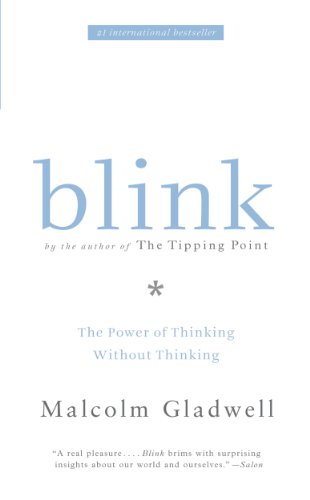

This article is an excerpt from the Shortform summary of "Blink" by Malcolm Gladwell. Shortform has the world's best summaries of books you should be reading.
Like this article? Sign up for a free trial here .
What is Malcolm Gladwell’s Blink about? What is the key message to take away from the book?
In his book Blink, Gladwell questions the widespread assumption that snap judgments are bad, asking: How do our snap judgments compare to our rational, well-thought-out decisions? He argues that our snap judgments are often just as good as our deliberate decisions.
Below is our Blink book review, including background and critical reception.
About the Author
A New Yorker staff writer, Gladwell has made his name writing books that make social science research accessible and digestible to the layperson. He’s garnered praise for both his lucid, enthusiastic presentation of cutting-edge research and the novel connections he makes across a wide range of fields. His books include The Tipping Point (2000), Outliers (2008), David and Goliath (2013), and Talking to Strangers (2019).
Some have critiqued Gladwell’s work for oversimplifying complex concepts, relying too heavily on anecdotes rather than research, and generally lacking academic rigor. Such an “impressionistic take on the scientific method” has earned him the moniker “America’s Best-Paid Fairy-Tale Writer.” But, as Gladwell has said in multiple interviews, he is primarily a journalist and a storyteller, and he’s unabashed about his desire to write at the intersection of good stories and interesting research.
Whether you love him or hate him, you can’t ignore Gladwell: His reach is extraordinary—his books, the first five of which were New York Times best sellers, have sold millions of copies in dozens of countries, and he’s popularized now-well-known concepts such as the “broken windows theory” (in The Tipping Point) and the “10,000-hour rule” (in Outliers). If you’re familiar with the Pareto principle, the “stickiness factor,” or the “talent myth,” chances are good you have Gladwell to thank.
Connect with Gladwell:
Historical Context
Gladwell’s personal experience with racial stereotyping prompted him to research and write Blink. When Gladwell, who is half-Jamaican, let his hair grow, he noticed that police and security guards began to treat him differently. He was issued more speeding tickets and targeted by the police as a potential rapist. This led him to think more carefully about the far-reaching effects of snap judgments.
Intellectual Context
Blink was Gladwell’s second book. It followed his bestseller The Tipping Point (2000), in which he debuted his signature anecdotal style in book-length format. (He had already been producing similar stories for The New Yorker for several years.) The Tipping Point examined the science of epidemics and translated this into a study of social epidemics and “viral” trends, helping to push these concepts into the mainstream.
As we might expect from “the 21st century’s defining zeitgeist surfer,” his choice of topic for Blink was similarly ahead of the curve. Blink was one of the first in a wave of pop psychology books that aimed to explain the workings of the human brain to a general readership. It followed cognitive psychologist Steven Pinker’s How the Mind Works (1997) and The Blank Slate (2002)
and psychologist David Myers’s Intuition: Its Powers and Perils, which covers much of the same ground in a more rigorous but less absorbing way. Blink was followed by Dan Ariely’s Predictably Irrational (2009), Richard Thaler’s Nudge (2009), and Daniel Kahneman’s Thinking, Fast and Slow (2011).
The Book’s Impact
Among other honors, Blink was one of Fast Company’s best business books of 2005, and it spent over a year on various bestseller lists.
The book’s light, anecdotal style helped it to find a wide audience. For many readers, it provided an accessible entry point into cognitive science, reinvigorating the pop psychology genre and igniting public interest in the inner workings of the mind.
Critical Reception
Most Blink book reviews praised its stylistic elements while expressing some reservations about its rigor and overall structure. Time reviewer Lev Grossman, for example, praised the intellectual clarity that Gladwell brought to Blink and likened him to “an omniscient, many-armed Hindu god of anecdotes,” while at the same time questioning the basis for some of Gladwell’s claims. Similarly, Kirkus Reviews commended the anecdotal style but went on to say that the narratives “don’t add up to anything terribly profound.” Reviewer David Brooks wrote in The New York Times that the snap judgment part of his brain had been engaged and impressed by Blink, while the more analytical part was left unsatisfied.
Blink sparked a number of memorably titled reviews and responses, including Blinkered (in which reviewer Richard Posner described Blink as “written like a book intended for people who do not read books”), Blink and You Miss It: The Meaninglessness of Malcolm Gladwell, and the conservative rejoinder Think! Why Crucial Decisions Can’t Be Made in the Blink of an Eye.
The Book’s Approach
Blink is highly anecdote-driven. The individual narratives have strong internal momentum, but the whole book doesn’t read as much more than the sum of its parts. Gladwell himself, looking back on the book three years later, acknowledged that his general approach at the time had been “This is a lot of cool stuff! Do with it as you will!”
Gladwell tends to present his articles and books as mere “conversation starters,” encouraging interested readers to find and read the original academic work and expand their intellectual horizons from there.
———End of Preview———

Like what you just read? Read the rest of the world's best summary of "Blink" at Shortform . Learn the book's critical concepts in 20 minutes or less .
Here's what you'll find in our full Blink summary :
- How you can tell if a marriage will fail, within 3 minutes
- Why your first impressions are usually surprisingly accurate
- The dark side to making first impressions, and how to avoid the,






